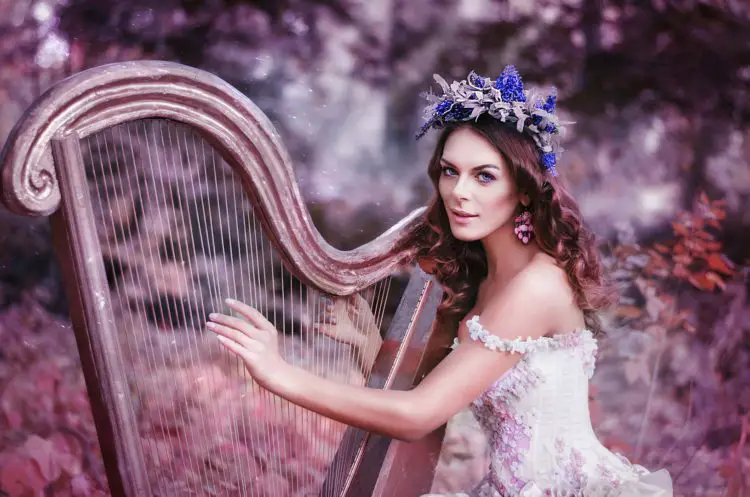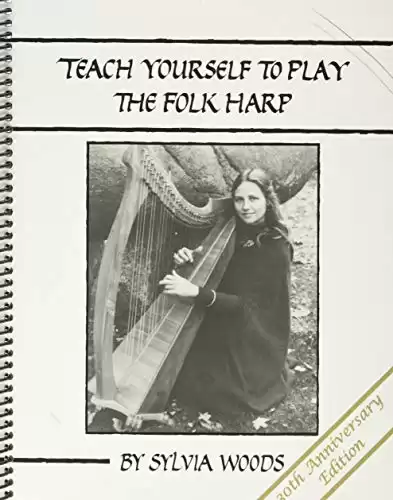The harp is a fascinating instrument. It delivers classical music, Celtic tributes, and rock rhythms. Is it any wonder why musicians enjoy hearing what it can do?
It’s also an instrument that comes with some challenges. It has over ten times the number of strings of a bass guitar, weighs more than a small child, and requires the coordination of a pianist.
If you feel like you’re up for the challenge, here are the facts you’ll want to know about playing the harp for the first time.
How Hard Is It to Learn to Play the Harp?
At its basic level, a harp is not difficult to learn how to play. Since it doesn’t require bowing or fretting, musicians only need to recognize string placement while reading sheet music. The harp becomes closer to the piano at a more advanced level, requiring time to develop technical proficiency.
The primary difficulty that harp players encounter when playing this instrument is the coordination required. A harpist always uses the first four fingers of each hand to play the strings.
Both hands work separately, on opposite sides of the instrument, to produce sounds from the 47 strings on the harp. The musician also has foot pedals to change pitches while playing.
This combination of activities takes a lot of time to get used to doing for new harpists. Even though it’s a stringed instrument, the rhythm it requires for a successful experience takes it closer to a percussion setup.
Without a steady rhythm, even correct notes will sound incorrect to the listener.
Additional considerations that harpists must review include endurance, physical strength, and knowledge of how individual instruments perform. No two harps play the same way. A professional harp can easily weigh 100 pounds.
■ What Is the Difference between a Harper and a Harpist?
There are two different ways that musicians can approach playing the harp. They can choose to be a “harper” or a “harpist.” A third option is a hybrid between the two.
You are a harper if you play something on the instrument by memory or from listening to other sounds or music around you. It’s rarely with sheet music, and it’s often seen when performances involve traditional or folk music.
People who are harpists typically read the music as they play the instrument. It’s seen most often for jazz, Celtic, and classical pieces where pedals are necessary.
You can play both styles as a musician, but there isn’t a name for the hybrid approach. You’ll be a harper or a harpist, depending on which style you’re using for that particular piece.
What Is the Cost of a Harp Today?
An entry-level harp is typically around $1,000. When you purchase an instrument in that price range, you’re getting an imported model from southeast Asia. They tend to play more like ropes than strings, but it can be an effective way to see if you’d want to play this instrument.
When you want to experiment with a harp, a 27-string model is typically a little cheaper. You can get one for about $1,500 in most locations. It’s light enough for lessons, but it won’t deliver the entire playing experience. Most of them at this level will not come with any levers.
The one I’d recommend is the 29-string harp by Rosebeck which even comes with Chelby levers, it’s an incredibly good deal and will only set you back a few hundred dollars, though it sometimes sells out, so you should get it while you can.
If you want a harp with levers, the goal should be to manage whatever you can afford. Although decent levers are expensive, you don’t want to buy cheap ones.
It’s better to get an unlevered instrument since you’ll be dealing with key changes, the Rosebeck being the exception for beginners and enthusiasts.
Since the levers aren’t usually necessary for the first year of learning, a harp that lets you develop positive habits and train the fingers to play in the required patterns is your best option.
When all the strings are in the correct key, you won’t need to worry about hitting the wrong note.
When you are ready to step up to a professional instrument, the cost ranges from the price of a late-model sedan to a small home. You can expect to pay between $50,000 to $150,000 for most harps in this category, with some models going even higher.
How Many Strings and Pedals Are on a Harp?
The modern concert harp has a very different appearance than its predecessors in the centuries before. It has transformed from an instrument played in pubs for folk music to a necessary inclusion for symphonic and philharmonic orchestras.
When you play a concert harp, you’ll need to navigate 47 strings and seven foot pedals. That combination allows the musician to play chromatic notes when there’s enough time to adjust to the changes.
Composers use concert harps to support melodic harmonies, add definition to note starting, or even bass phrases. It delivers a sweeping sound that feels more like a musical atmosphere.
The concert harp is only one version of this instrument that you can learn how to play. Here are some other designs that come with different string counts.
| Lever Harp: | This harp gets its name from the levers found on each string. A harpist can play two separate notes with this design. Since it has extra versatility, the design only uses 34 strings. It’s one of the most common choices for beginners. |
| Pedal Harp: | The pedal harp is a close replica of the concert version of this instrument. It still comes with seven pedals, but some designs have 46 strings instead of 47. |
| Celtic Harp: | This harp comes with several different designs, all of which can impact the number of available strings. Some of them have as few as 22, while others can have 38. The instrument gets its name from the region that developed its sound, delivering a tone range of up to six octaves. |
| Multicourse Harp: | With this instrument, a harper or harpist has multiple string rows to play. The standard design has one row, but you can find designs with three rows with this option. If you have a model with 23 strings and three rows, you will end up with 69 total playing possibilities. |
| Electric Harp: | When you play this harp option, you’re getting a concert-style experience while using an electrical power source to generate notes. Some models even provide the seven pedals. Most designs use somewhere between 40 to 47 strings to help musicians produce their sounds. |
| Lyre: | This ancient harp started with only four strings. Luthiers started adding more as the years passed, evolving it to eight- and ten-string designs. A modern lyre offers up to 16 strings, but you’ll rarely see one with fewer than seven. It was one of the most loved instruments in Greece and Rome during that era in human history. |
| Lap Harp: | With this harp, you’ll have an instrument that fits in your lap. The first designs came out in the 9th or 10th centuries, providing an alternative to the lyre. Since it’s a smaller option, most have between 15 to 18 strings. The larger models can have up to 22. |
The tone range for a standard harp can travel from the C1 note to G7. The strings should have colors on them to help harpers and harpists find the current sounds quickly.
Each C-string should be colored red, while the F-strings are typically black. This design element isn’t mandatory, especially for harps that don’t have more than a couple of octaves.
Understanding the Registers for Playing the Harp
When you learn how to play the harp, you’ll find that the note sequences typically fall within three generic registers.
- The Low Register. Single notes or chords typically work better in this area of the harp because of the higher resonance levels. Most instruments use steel strings to maximize this advantage for the lowest notes.
- The Central Register. Chords are more ideal when playing the strings in the central part of the instrument. You can also use short running notes or manual arpeggios to deliver compositional support. Most musicians prefer to use gut strings for these sounds.
- The High Register. It’s usually better to focus on short running notes only when playing in this portion of the register. That’s because the sounds don’t ring out as much. Nylon strings work the best, and they’ll sound like a guitar when plucked correctly.
Although these points are treated as guiding principles, they should not be considered an unbreakable rule.
Musicians have the freedom with the harp to express themselves in unique and emotional ways. With so many string combinations to try, you can create harmonies and sounds that are distinctively you.
That’s why the harp is such a beautiful instrument to learn how to play. It makes a visual and auditory impact on the senses.
A Final Idea to Consider When Playing the Harp
When you want to learn how to play the harp, renting an instrument for a few months is often easier than committing to a purchase. Some players find that they love the sound it makes, but they don’t like how to produce notes from the strings. You can pursue rent-to-own opportunities to generate equity in this investment.
I highly recommend finding someone who can provide one-on-one lessons if you want to play the harp.
Although YouTube videos and group classes on Zoom are both helpful in some ways, it’s much easier to find the resources needed for your playing style from an experienced teacher.
The disadvantage of a one-on-one lesson is its cost. Playing the harp is a specialized skill, so you might encounter a lack of providers.
Group lessons are fun if you want a sociable experience. If you’re shy around others or need more help from the teacher, you might find this option to be overly stressful.
I had a lot of fun using instructional books to learn how to play the harp. Although I didn’t go beyond the second year, I found the lessons in “Teach Yourself to Play the Folk Harp” to be very helpful.
As for the instrument, I chose the Roosebeck 29-String Minstrel Harp to develop my playing style.
It comes with Chelby levers to make it easy to change the keys. You’ll get to play four octaves, from C3 to C7, which makes it the perfect learning instrument.
I love how the Roosebeck is made from solid wood. With the ply soundboard, the strength and quality of each note were surprisingly good.
If you’ve ever thought about picking up an instrument, the harp is a suitable choice. It might not be the cheapest one to learn, but it’s comparable to the guitar in total costs.




